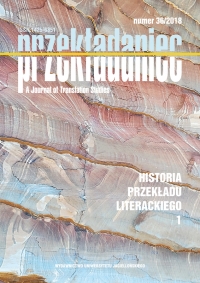O niewidoczności tłumacza raz jeszcze. Na przykładzie tłumaczek w Polsce 1697–1763
Translator’s Invisibility Revisited: The Case of Women Translators in Poland in 1697–1763
Author(s): Karolina DębskaSubject(s): Gender Studies, Sociology, 17th Century, 18th Century, Translation Studies
Published by: Wydawnictwo Uniwersytetu Jagiellońskiego
Keywords: habitus; translatorial behaviour; social trajectory; capital; women translators; sociology of translation; history of translation; 18th-century women translators; translator’s invisibility;
Summary/Abstract: This paper analyses the impact of social trajectories of translators on their translatorial behaviour on the example of women translators in Poland in the years 1697–1763. My aim is to find out who they were as well as sketch the circumstances in which they had to live and work and analyse how it impacted their translatorial behaviour. It is assumed that translatorial habitus makes translators invisible and submissive. In the article, I argue the contrary: in the case of early women translators in Poland, taking up this profession required high status and lead to increased visibility.
Journal: Przekładaniec.
- Issue Year: 2018
- Issue No: 36
- Page Range: 60-81
- Page Count: 22
- Language: Polish

